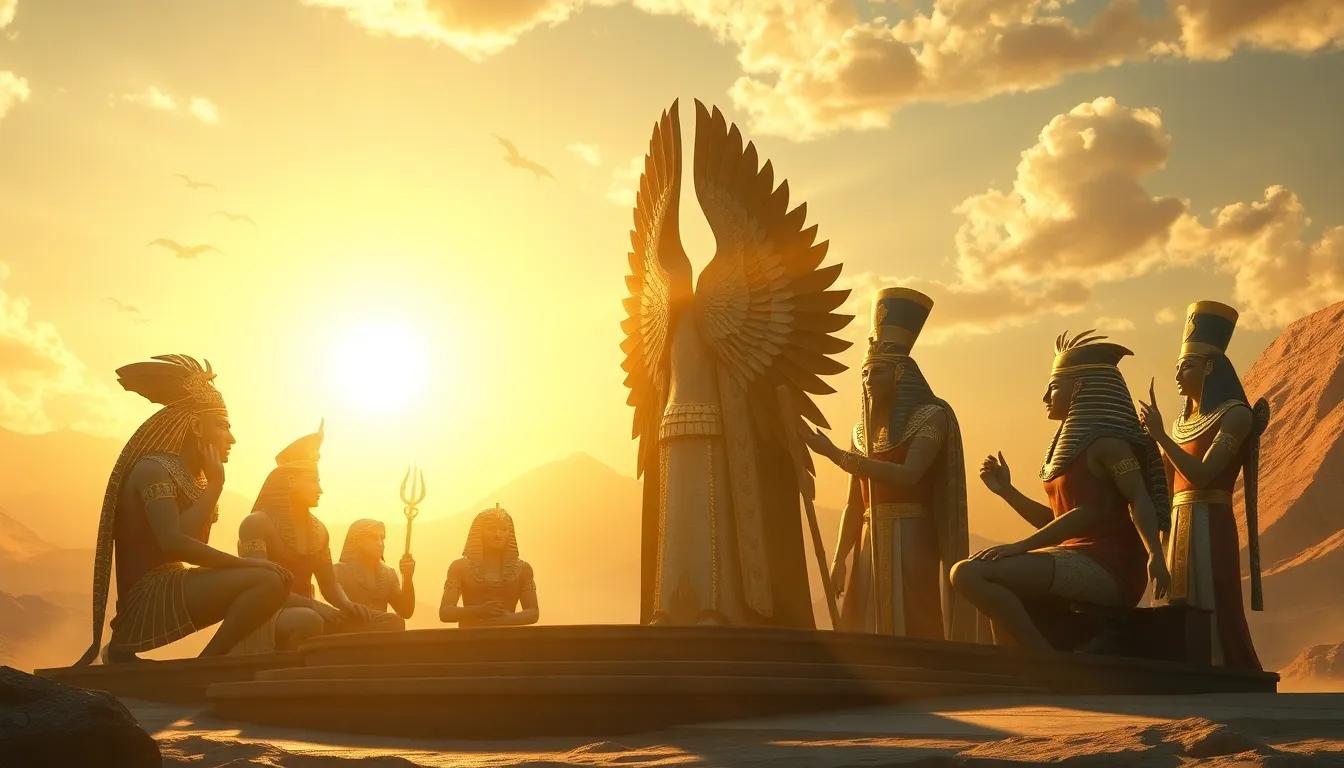The Divine Council: The Meeting of Egyptian Gods
I. Introduction to the Divine Council
The Divine Council, also known as the Council of the Gods, is a significant concept in ancient Egyptian mythology, embodying the collective governance of deities over the cosmos. This assembly of gods not only highlights the hierarchical structure of Egyptian deities but also reflects the society’s understanding of order, justice, and the divine.
In ancient Egypt, gods were not only worshipped but also integrated into the daily life and governance of the people. They were considered to be the guardians of Ma’at, the principle of truth, balance, and cosmic order. The Divine Council played a crucial role in upholding these ideals, making it a cornerstone of Egyptian religion and culture.
II. Historical Context of the Divine Council
The origins of the Divine Council can be traced back to the early dynastic periods of Egypt, where the worship of various deities began to coalesce into more structured forms. Initially, local gods were revered in specific regions, but as the concept of a unified state emerged, so did the need for a central assembly of these divine beings.
Throughout different dynasties, particularly during the Old and New Kingdoms, the structure and composition of the Divine Council evolved. The influence of political changes, along with the merging of different local cults, led to the integration of new deities into the council, reflecting the dynamic nature of Egyptian religious beliefs.
III. Key Deities in the Divine Council
The Divine Council comprises several key deities, each with distinct roles and attributes. Some of the most prominent members include:
- Ra: The sun god, symbolizing creation and kingship.
- Osiris: The god of the afterlife, representing resurrection and fertility.
- Isis: The goddess of magic and motherhood, known for her protective and nurturing attributes.
- Horus: The sky god, often associated with kingship and protection.
- Anubis: The god of mummification and the afterlife, overseeing the transition of souls.
Each deity within the council played a vital role in maintaining order and balance, reflecting the complexity of the Egyptian pantheon.
IV. Structure and Function of the Divine Council
The hierarchy of the Divine Council was complex and multifaceted. At the top was Ra, who was often viewed as the supreme deity. Below him were major gods like Osiris, Isis, and Horus, who had significant influence over various aspects of life and the afterlife.
The functions of the Divine Council included:
- Maintaining cosmic order (Ma’at).
- Judging the souls of the deceased.
- Deciding the fate of humanity and the natural world.
- Overseeing the balance between chaos and order.
Through their deliberations and decisions, the gods ensured that the universe remained in harmony, reflecting the Egyptians’ belief in the interconnectedness of all things.
V. The Meetings of the Divine Council
The meetings of the Divine Council were not mere formalities; they were imbued with profound significance. Rituals often accompanied these gatherings, reinforcing the sacred nature of their decisions. Priests played a crucial role in conducting these rituals, which included offerings, prayers, and recitations of sacred texts.
Notable myths often feature the council’s deliberations, such as:
- The judgment of Osiris, where the council decides on the fate of souls.
- The conflict between Horus and Set, where the council intervenes to restore order.
These stories illustrate the dynamic interactions among the deities and their influence over human affairs.
VI. The Divine Council in Egyptian Literature and Art
The Divine Council is prominently represented in ancient Egyptian texts and inscriptions. The Book of the Dead, for example, contains numerous references to the council, detailing the judgment process that souls undergo after death.
Artistic depictions of the Divine Council can be found in temples and tombs, showcasing the gods in various poses, often seated in judgment or engaged in conversation. These representations served both a religious purpose and a decorative function, reinforcing the power and authority of the gods in the eyes of the worshippers.
VII. Comparisons with Other Mythological Councils
When comparing the Divine Council to other ancient mythological councils, similarities and differences emerge. For instance:
- In Greek mythology, the council of the gods is led by Zeus, similar to how Ra presides over the Egyptian council.
- Mesopotamian mythology features councils of gods that govern various aspects of life, akin to the responsibilities of the Egyptian Divine Council.
However, the Egyptian Divine Council uniquely emphasizes the judgment of souls and the maintenance of Ma’at, setting it apart from its counterparts in other cultures. The legacy of the Divine Council has also influenced later religious thought, particularly in concepts of divine governance and morality.
VIII. Conclusion
In summary, the Divine Council is a pivotal element in understanding ancient Egyptian beliefs. It encapsulates the intricacies of their cosmology, the roles of deities, and the importance of maintaining balance in the universe. The narratives surrounding the council provide insight into the values and priorities of ancient Egyptian society.
Reflecting on the lasting impact of these myths, we see their influence in contemporary culture and spirituality, reminding us of the universal quest for understanding the divine and the governance of our lives.




